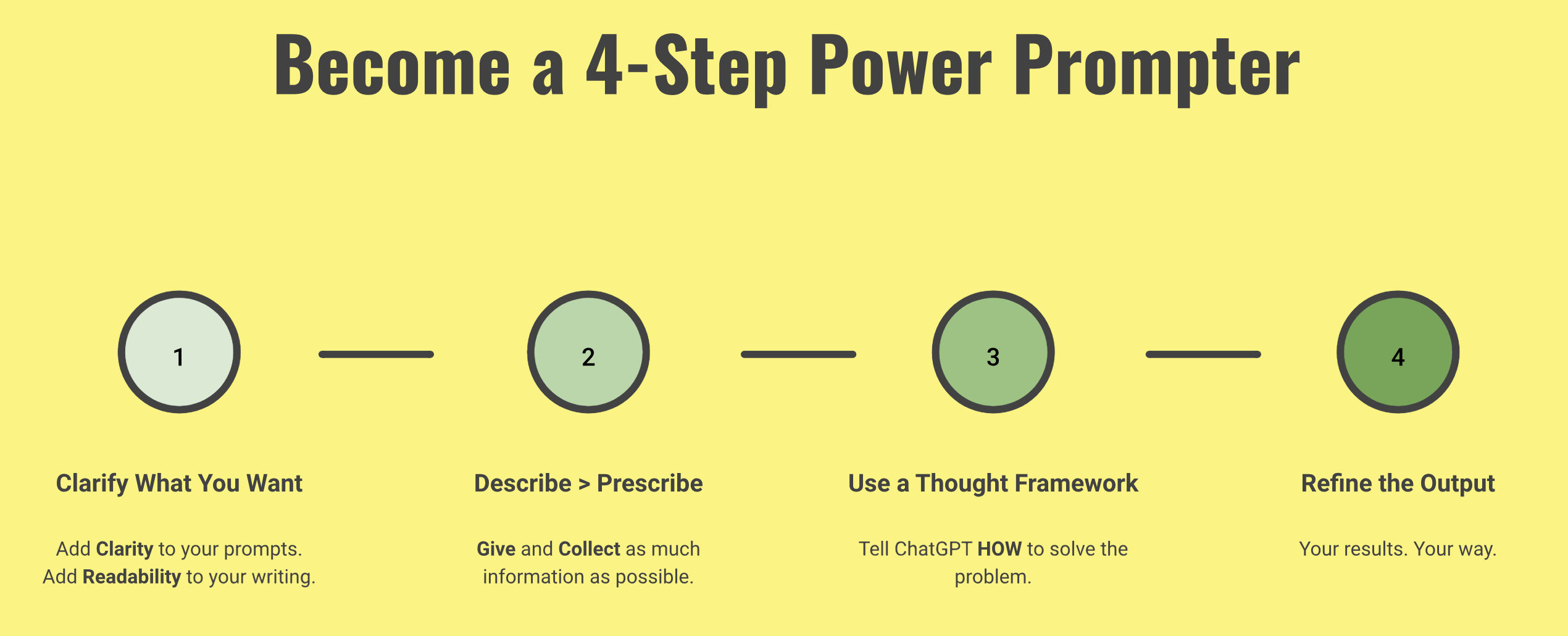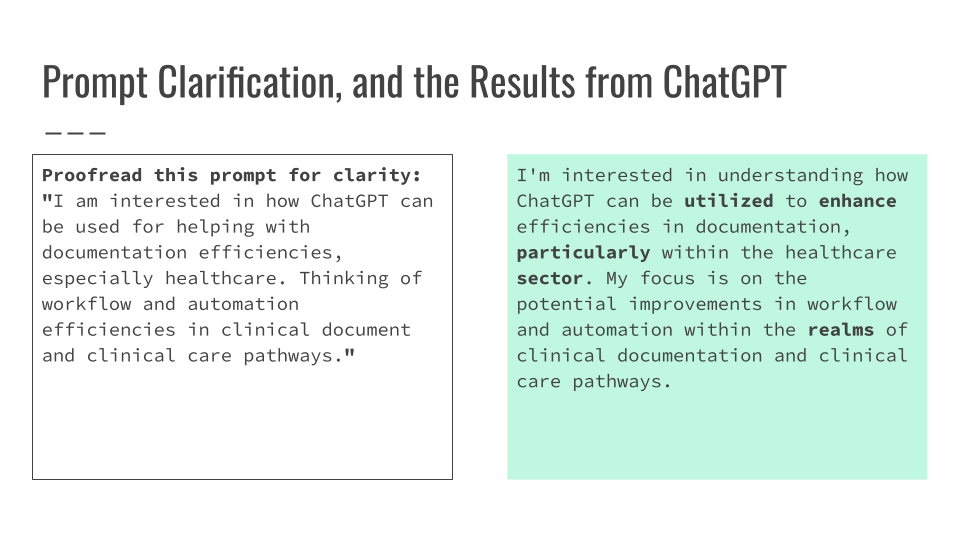Power Prompting with ChatGPT

Big thank you to Melissa and Allan at RevUp Capital for inviting me to speak about ChatGPT. And huge thanks to the company founders and investors for giving me their time and attention before, during, and after the presentation. Ya'll are in good hands!
The title of the talk was Power Prompting ChatGPT. Rather than discuss my book, I figured it would be more valuable to share all the screw-ups I made in learning ChatGPT and turn it into a super-focused guide to instant success. Behold. Power Prompting! We can do it in the following four steps:
- Clarify What You Want
- Describe > Prescribe
- Use a Thought Framework
- Refine the Output
Let's run through each step.

Step 1 of 4
Step 1 of Power Prompting is Clarifying what you want. That means before you ask ChatGPT a question, you’re going to make sure the question is worth asking. You do that by putting the question in a prompt as follows:
Proofread this prompt for clarity. "{prompt}"And ChatGPT will make a better question. Take a look at the example below:

The prompt on the right that ChatGPT generated is more coherent and focused. Always ask ChatGPT to add clarity to your prompts. If you’re looking for creative output, that may be the one instance where adding clarity isn’t beneficial.
Step 2 of 4
Step 2 of Power Prompting is Describe > Prescribe. That means that you need to tell ChatGPT what you know and then describe what it is you want to know. Some may presume they already have all the answers and simply seek validation from ChatGPT at this stage. But I urge you to take time and choose curiosity over commands. Keep in mind, you are about to interact with over 1 trillion unique data parameters; surely you deserve to hear the robot out, yeah? See the presentation below for detailed interaction of how to essentially use the Socratic method to extract as much info from ChatGPT as possible at this stage.
Step 3
Step 3 of Power Prompting is to Use a Thought Framework. In this step, you should guide ChatGPT by providing a model, process, theory, or framework to help it understand and analyze your prompt in the desired manner. There are several examples of thought frameworks that can be used, such as:
- SWOT Analysis: This is a strategic planning tool used in business to evaluate Strengths, Weaknesses, Opportunities, and Threats related to a project, product, place, industry, or person. It involves identifying the internal and external factors that are favorable and unfavorable to achieve an objective.
- AIDA Model: This marketing model describes the stages a consumer goes through in the purchasing process. AIDA stands for Attention, Interest, Desire, and Action. The model proposes that advertising messages must accomplish these four steps to motivate consumers to act.
- Buyer Persona: This is a semi-fictional representation of your ideal customer based on market research and real data about your existing customers. It helps businesses understand and relate to an audience they want to market their products or services.
- Go-to-Market Strategy: This tactical action plan outlines how a company will sell its products or services to customers. The strategy typically includes the target audience, the unique value proposition, the sales and marketing strategy, and the business model.
- Tree of Thoughts Prompting: This technique is used for critical thinking and problem-solving. It involves starting with a central problem or question and generating a “tree” of related sub-questions, ideas, and solutions. Each branch of the tree represents a new line of thought or aspect of the problem, allowing for a comprehensive exploration of the topic. It can help facilitate in-depth conversations with AI by providing a structured way to explore complex issues.
With the thought framework, ChatGPT brings the brain. You bring the framework. Better luck next time, human. That’s just the way it is.
Step 4
Finally, Step 4 of Power Prompting is to Refine the Output. Once you have all the juicy information, refine it as necessary using specific instructions about the format, perspective, and style you want. Prompts such as “Give me the results in a table format,” “Add a column of examples,” “Change the perspective to first person,” or “Add relevant hyperlinks” allow you to fine-tune the output to your specific needs.
I hope Power Prompting offers a powerful and practical approach to using ChatGPT more effectively. You'll get better results by defining your goal clearly, providing ample context, using a structured thought framework, and fine-tuning the output. It’s suitable for anyone looking to utilize AI for tasks ranging from generating content, solving problems, conducting research, and much more. Remember, the key to successful AI interactions lies in the art of asking the right questions in the right way. Happy prompting, and go prompt yourself!
The presentation is below.

